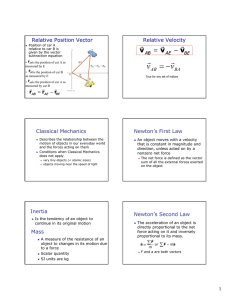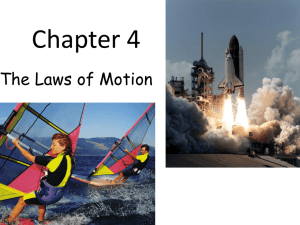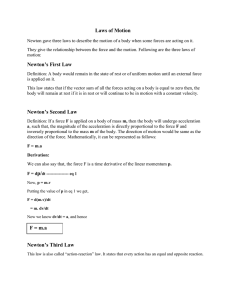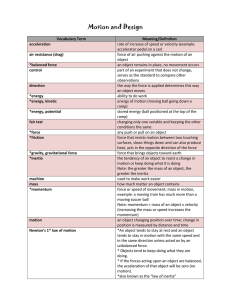Chapter 4 – Forces and the Laws of Motion
advertisement
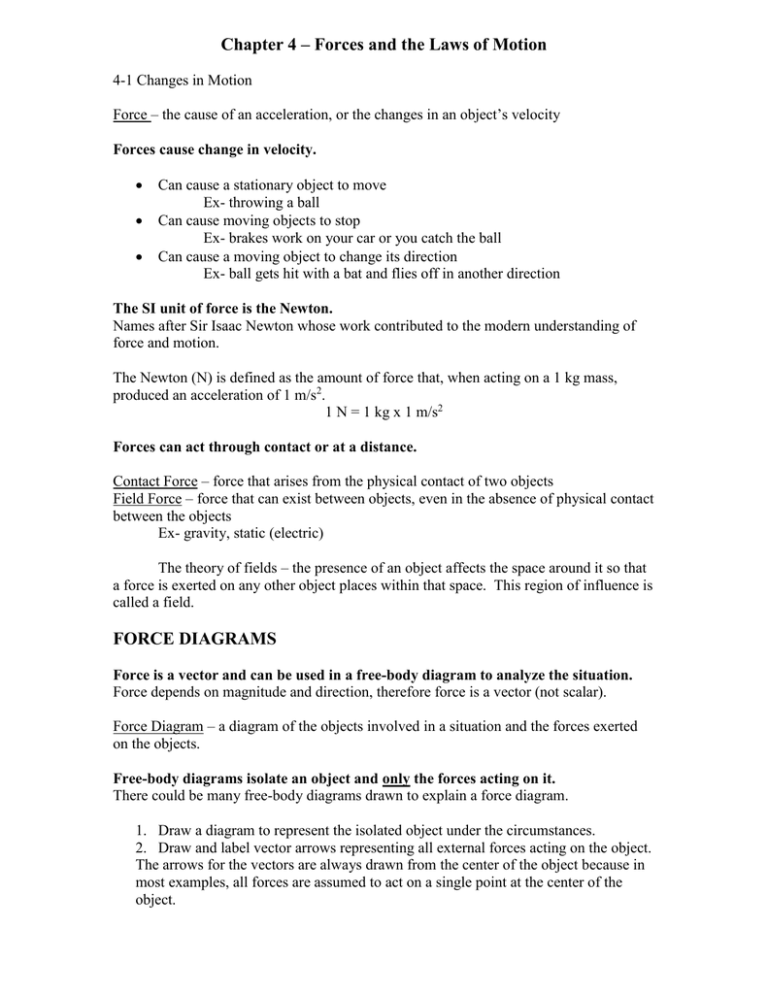
Chapter 4 – Forces and the Laws of Motion 4-1 Changes in Motion Force – the cause of an acceleration, or the changes in an object’s velocity Forces cause change in velocity. Can cause a stationary object to move Ex- throwing a ball Can cause moving objects to stop Ex- brakes work on your car or you catch the ball Can cause a moving object to change its direction Ex- ball gets hit with a bat and flies off in another direction The SI unit of force is the Newton. Names after Sir Isaac Newton whose work contributed to the modern understanding of force and motion. The Newton (N) is defined as the amount of force that, when acting on a 1 kg mass, produced an acceleration of 1 m/s2. 1 N = 1 kg x 1 m/s2 Forces can act through contact or at a distance. Contact Force – force that arises from the physical contact of two objects Field Force – force that can exist between objects, even in the absence of physical contact between the objects Ex- gravity, static (electric) The theory of fields – the presence of an object affects the space around it so that a force is exerted on any other object places within that space. This region of influence is called a field. FORCE DIAGRAMS Force is a vector and can be used in a free-body diagram to analyze the situation. Force depends on magnitude and direction, therefore force is a vector (not scalar). Force Diagram – a diagram of the objects involved in a situation and the forces exerted on the objects. Free-body diagrams isolate an object and only the forces acting on it. There could be many free-body diagrams drawn to explain a force diagram. 1. Draw a diagram to represent the isolated object under the circumstances. 2. Draw and label vector arrows representing all external forces acting on the object. The arrows for the vectors are always drawn from the center of the object because in most examples, all forces are assumed to act on a single point at the center of the object. 3. Draw the gravity vector which is almost always a force directed toward the center of the Earth. Labeled as Fg. 4. Draw the opposite force which is almost always a force directed upward from object or substance the object is on. Labeled as Fn 5. Draw a vector to represent the direction of the object’s motion. Labeled as F 6. Draw a vector to represent the opposite force of friction on the object. Labeled F(resistance) Practice: p. 128 #1-6 in Textbook (Together in class) p. 17 #1-3 in Section Review (Together in class) 4-2 Newton’s First Law In the 1630’s, Galileo realized that a clock sliding on a perfectly smooth surface would slide forever in the absence of an applied force. He concluded correctly that it is not the nature of an object to stop once it is set in motion; rather it is an object’s nature to maintain its state of motion. This concept was further developed by Newton in 1687 and has come to be known as Newton’s First Law of Motion. Newton’s First Law of Motion An object at rest remains at rest, and an object in motion continues in motion with constant velocity unless the object experiences a net external force. Inertia – the tendency of an object to maintain its state of motion. Newton’s first law is sometimes referred to as the law of inertia. Therefore combining the definition for inertia and Newton’s 1st Law, Newton’s Law states: when the net external force on an object is zero, its acceleration (or change in its velocity) is zero. Acceleration is determined by net external force. Draw a force diagram for a car driving eastward down the road. Fn F resistance F Fg F = forward force of the road on the tires F resistance = acts in the opposite direction as F and is due partly to friction between the road surface and tires and partly air resistance Fg = downward force of gravity on the car Fn = the normal force or the upward force of the road on the car How can a car maintain a constant velocity with all these vectors forces? You first have to understand the definition of external force and net external force. External force - is a single force that acts on an object as a result of the interaction between the object and its environment. Net external force – the total force resulting from a combination of external forces on an object; sometimes called the resultant force And then, realize that velocity and acceleration are determined by the net external force. What has to occur to the vectors to keep the car to maintain a constant velocity? The vector sum of these forces is equal to zero. Example Figure 4-7 on p. 131 TUG –O-WAR If both teams pull on the rope with equal but opposite force = the net external force on the rope is equal to zero. The knot in the center of the rope will be at rest even with both forces pulling on it. Objects can be at equilibrium even when forces act on it. If one team increases the force of its pull, the knot will experience a net external force equal to the difference in the forces (2N – 4N = -2N of force), and it will accelerate in the direction of the greater pull. Practice: p. 18 Section Review #1-3 (Together in class) Practice 4A #1-4 Mass is a measurement of inertia. The inertia of an object is proportional to its mass. The greater the mass of a body, the less the body accelerates under an applied force. Similarly, a light object will undergo a larger acceleration than a heavy object under the same force. Therefore, mass, which is a measure of the amount of matter in an object, is also a measure of the inertia of an object. Objects in motion tend to stay in motion. Quick Lab p. 134 Equilibrium – the state in which there is no change in a body’s motion. An object is in equilibrium when the vector sum of the forces acting on it is equal to zero. When the sum of all forces in the x direction is equal to zero and the sum of all forces in the y direction is equal to zero, then the vector sum of all forces acting on the body is equal to zero and the body is in equilibrium. Section Review p. 135 #1-5 in textbook (Together in class) 4-3 Newton’s Second & Third Laws Force is proportional to mass and acceleration. It requires much less force to accelerate a low mass object rather than it does to accelerate a high mass object at the same rate. This is because an object with smaller mass has less inertia, or tendency to maintain its state of motion, than an object with greater mass. Ex. – pushing a car with only one person pushing and pushing with many people Newton’s Second law related force, mass, and acceleration. Newton’s Second Law The acceleration of an object is directly proportional to the net external force acting on the object and inversely proportional to the object’s mass. In other words, if equal forces are applied to two objects of different masses, the object with greater mass will experience a smaller acceleration and the object with less mass will experience a greater acceleration. ∑F = ma net external force = mass x acceleration You may need to break the problem down into components. Find the x component to find the sum of the forces in the x direction (∑Fx = max) and find the y components to find the sum of the forces in the y direction (∑Fy = may). If the net external force is zero, then a=0, which corresponds to the equilibrium situation where velocity is constant or at zero. Practice: Practice 4B p. 138 #1-5 Newton’s Third Law If two objects interact, the magnitude of the force exerted on object 1 by object 2 is equal to the magnitude of the force simultaneously exerted on object 2 by object 1, and these two forces are opposite in direction. In other words, for every action, there is an equal and opposite reaction. In physics, the reaction force occurs at exactly the same time as the action force. Unlike we typically think as an action causes a reaction after the action in response. Because the forces coexist, either force can be called the action or the reaction. Action and reaction forces each act on different objects. Action-reaction pair – a pair of simultaneous equal but opposite forces resulting from the interaction of two objects. The concept of action-reaction pairs is a common source of confusion because some people assume incorrectly that the equal and opposite forces balance one another and make any change in the state of motion impossible. Question: If a nail exerts a force on the hammer that is equal to the force the hammer exerts on the nail, why does the nail remain at rest? Answer: The motion of the nail is affected only by the forces acting on the nail. The force the nail exerts on the hammer affects only the hammer, not the nail.

